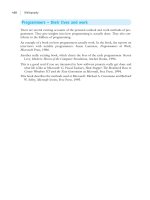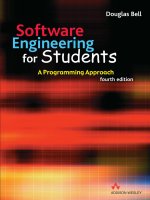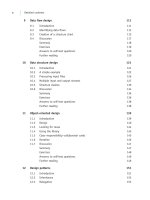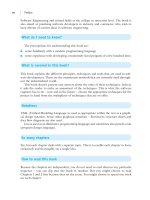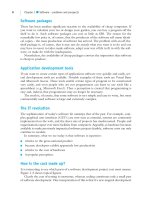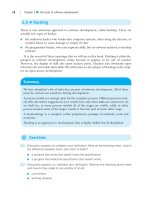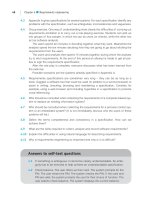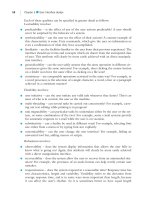Software Engineering For Students: A Programming Approach Part 1 docx
Bạn đang xem bản rút gọn của tài liệu. Xem và tải ngay bản đầy đủ của tài liệu tại đây (6.34 MB, 10 trang )
for Students
Software
Engineering
for Students
Douglas Bell
A Programming Approach
Software
Engineering
for Students
A Programming Approach
Software
Engineering
for Students
A Programming Approach
This fully revised version of Douglas Bell’s Software Engineering: A Programming Approach continues to use
the successful formula of the previous editions. The author’s approach is to present the main principles,
techniques and tools used in software engineering, one by one, chapter by chapter. He provides the reader
with the knowledge to select the appropriate techniques for the project in hand. He builds on the reader’s
experience of coding small-scale applications, and examines everything they will need to begin programming
large-scale software systems. This book is a unique introduction to software engineering for all students of
computer science and its related disciplines. It is also ideal for practitioners wishing to remain current with
new developments in the area.
Features
● Pragmatic, non-mathematical approach
● Self-test questions within each chapter help the reader to fully understand the concepts
● Numerous exercises are provided at the end of each chapter
● Consistent use of the UML as a design notation
● Case studies used throughout
● An accompanying website with even more teaching and learning resources
Douglas Bell is a lecturer at Sheffield Hallam University in the UK. He has authored and co-authored
a number of texts, including the best-selling Java for Students.
“Bell covers the main areas of software engineering with
accuracy and authority, and without getting bogged down
in superfluous detail. My students actually like this book;
it's very readable.”
Martin Bush, South Bank University
Douglas Bell
Douglas Bell
Software Engineering
www.pearson-books.com
fourth edition
fourth edition
fourth edition
an imprint of
Software Engineering
for Students
BELL_A01.QXD 2/2/05 3:20 PM Page i
We work with leading authors to develop the
strongest educational materials in computing,
bringing cutting-edge thinking and best learning
practice to a global market.
Under a range of well-known imprints, including
Addison-Wesley, we craft high quality print and
electronic publications which help readers to
understand and apply their content, whether
studying or at work.
To find out more about the complete range of our
publishing, please visit us on the World Wide Web
at: www.pearsoned.co.uk
BELL_A01.QXD 2/2/05 3:20 PM Page ii
Software Engineering
for Students
A Programming Approach
Fourth Edition
DOUGLAS BELL
BELL_A01.QXD 2/2/05 3:20 PM Page iii
Pearson Education Limited
Edinburgh Gate
Harlow
Essex CM20 2JE
England
and Associated Companies throughout the world
Visit us on the World Wide Web at:
www.pearsoned.co.uk
First published under the Prentice Hall imprint 1987
Second edition 1992
Third edition 2000
Fourth edition 2005
© Prentice Hall International 1987, 1992
© Pearson Education Limited 2000, 2005
The right of Douglas Bell to be identified as author of this work has been asserted by him in accordance
with the Copyright, Designs and Patents Act 1988.
All rights reserved. No part of this publication may be reproduced, stored in a retrieval system, or trans-
mitted in any form or by any means, electronic, mechanical, photocopying, recording or otherwise,
without either the prior written permission of the publisher or a licence permitting restricted copying in
the United Kingdom issued by the Copyright Licensing Agency Ltd, 90 Tottenham Court Road,
London W1T 4LP.
The programs in this book have been included for their instructional value. They have been tested with
care but are not guaranteed for any particular purpose. The publisher does not offer any warranties or
representations nor does it accept any liabilities with respect to the programs.
All trademarks used herein are the property of their respective owners. The use of any trademark in this
text does not vest in the author or publisher any trademark ownership rights in such trademarks, nor
does the use of such trademarks imply any affiliation with or endorsement of this book by such owners.
ISBN 0 321 26127 5
British Library Cataloguing-in-Publication Data
A catalogue record for this book is available from the British Library
Library of Congress Cataloging-in-Publication Data
Bell, Doug, 1944-
Software engineering for student/Douglas Bell. 4th ed.
p. cm.
Rev. ed. of: Software engineering. 2000.
ISBN 0-321-26127-5
1. Software engineering. 2. Computer programming. I. Bell, Doug, 1944-
Software engineering. II. Title.
QA76.758.B45 2005
005.1 dc22
2004062346
10987654321
09 08 07 06 05
Typeset in 9.75/12pt Galliard by 71
Printed in Great Britain by Henry Ling Ltd, at the Dorset Press, Dorchester, Dorset
The publisher’s policy is to use paper manufactured from sustainable forests.
BELL_A01.QXD 2/2/05 3:20 PM Page iv
Contents
Part A
●
Preliminaries 1
1. Software – problems and prospects 3
2. The tasks of software development 22
3. The feasibility study 30
4. Requirements engineering 36
Part B
●
Design 51
5. User interface design 53
6. Modularity 67
7. Structured programming 87
8. Functional decomposition 102
9. Data flow design 111
10. Data structure design 121
11. Object-oriented design 139
12. Design patterns 151
13. Refactoring 165
Part C
●
Programming languages 173
14. The basics 175
15. Object-oriented programming 200
16. Programming in the large 221
17. Software robustness 237
18. Scripting 259
Preface xix
v
BELL_A01.QXD 2/2/05 3:20 PM Page v
vi Contents
19. Testing 267
20. Groups 283
Part D
●
Verification 265
Part E
●
Process models 289
21. The waterfall model 291
22. The spiral model 297
23. Prototyping 303
24. Incremental development 314
25. Open source software development 322
26. Agile methods and extreme programming 330
27. The unified process 337
Part F
●
Project management 345
28. Teams 347
29. Software metrics and quality assurance 357
30. Project management 370
Part G
●
Review 383
31. Assessing methods 385
32. Conclusion 392
Appendices 405
A. Case studies 407
B. Glossary 411
C. UML summary 412
Bibliography 417
Index 419
BELL_A01.QXD 2/2/05 3:20 PM Page vi
Detailed contents
Preface xix
1 Software – problems and prospects 3
1.1 Introduction 3
1.2 Meeting users’ needs 4
1.3 The cost of software production 5
1.4 Meeting deadlines 10
1.5 Software performance 10
1.6 Portability 11
1.7 Maintenance 11
1.8 Reliability 13
1.9 Human–computer interaction 16
1.10 A software crisis? 16
1.11 A remedy – software engineering? 17
Summary 18
Exercises 19
Answers to self-test questions 20
Further reading 20
2 The tasks of software development 22
2.1 Introduction 22
2.2 The tasks 23
2.3 Process models 26
2.4 Methodology 27
2.5 Hacking 28
Summary 28
Exercises 28
Answer to self-test question 29
Part A
●
Preliminaries 1
vii
BELL_A01.QXD 2/2/05 3:20 PM Page vii
3 The feasibility study 30
3.1 Introduction 30
3.2 Technical feasibility 31
3.3 Cost-benefit analysis 31
3.4 Other criteria 32
3.5 Case study 32
3.6 Discussion 34
Summary 34
Exercises 34
Answers to self-test questions 35
Further reading 35
4 Requirements engineering 36
4.1 Introduction 36
4.2 The concept of a requirement 37
4.3 The qualities of a specification 38
4.4 How to elicit requirements 40
4.5 The requirements specification 41
4.6 The structure of a specification 42
4.7 Use cases 45
4.8 Use case diagrams 46
Summary 47
Exercises 47
Answers to self-test questions 48
Further reading 49
5 User interface design 53
5.1 Introduction 53
5.2 An inter-disciplinary field 54
5.3 Styles of human–computer interface 54
5.4 Different perspectives on user interface design 56
5.5 Design principles and guidelines 57
5.6 Interface design 60
5.7 Case study 62
5.8 Help systems 63
Summary 64
Exercises 64
Part B
●
Design 51
viii Detailed contents
BELL_A01.QXD 2/2/05 3:20 PM Page viii
Detailed contents ix
Answers to self-test questions 65
Further reading 65
6 Modularity 67
6.1 Introduction 67
6.2 Why modularity? 68
6.3 Component types 70
6.4 Component size and complexity 70
6.5 Global data is harmful 73
6.6 Information hiding 74
6.7 Coupling and cohesion 76
6.8 Coupling 77
6.9 Cohesion 79
6.10 Object-oriented programming 82
6.11 Discussion 84
Summary 84
Exercises 85
Answers to self-test questions 85
Further reading 86
7 Structured programming 87
7.1 Introduction 87
7.2 Arguments against
goto 89
7.3 Arguments in favor of
goto 92
7.4 Selecting control structures 94
7.5 What is structured programming? 96
Summary 98
Exercises 99
Answer to self-test question 100
Further reading 101
8 Functional decomposition 102
8.1 Introduction 102
8.2 Case study 103
8.3 Discussion 107
Summary 109
Exercises 109
Answer to self-test question 110
Further reading 110
BELL_A01.QXD 2/2/05 3:20 PM Page ix
